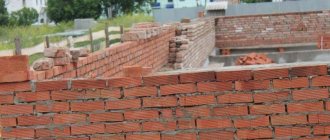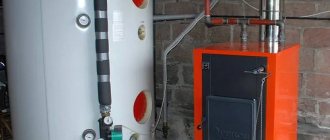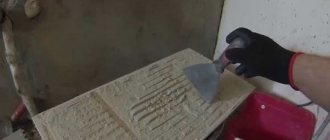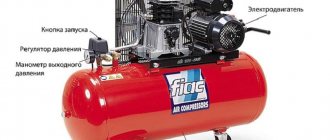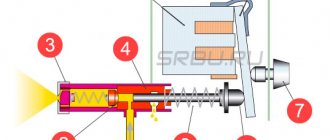A paint roller is a roller tool with a handle designed for applying paint to various surfaces.
It is the most popular tool for coloring, and not only that. These instruments come in different types, sizes, shapes and finishes. At the same time, the question of how to choose a paint roller depends on the type of work that you are going to carry out with its help.
Design features
Paint rollers have a fairly simple design. They consist of the following elements:
- The clasp is a bracket on which a roller with a fur coat is attached. It has a curved shape. A comfortable handle is installed at the end so that the tool fits comfortably in your hand.
- Lever. It is made of plastic, wood or rubberized material. Special depressions are made on it, repeating the shape of the fingers. This allows you not to be afraid that the roller will slip out of your hand.
- Video clip. It is a cylinder that rotates freely on a clasp. It is made of plastic or metal.
- Coat. Fits over the roller. It can be made of foam rubber, velor or faux fur with different pile lengths. This part of the roller is intended for applying paint.
Thanks to this design, the paint roller has advantages over other tools:
- productivity and speed of painting increases;
- it is permissible to use any type of paint;
- no hairs or other traces of the tool remain on the applied layer;
- paint is consumed less;
- There are no splashes or smudges during painting.
Only high-quality products have these advantages. Previously, in our country, rollers were produced according to GOST. Today, construction stores sell mainly imported goods.
Types of rollers by size
Its purpose will largely depend on the dimensions of the roller. For example, when painting walls, it is better to choose a tool with a wide working part, and rollers for corners should be short. The following roller sizes are available:
- Mini rollers. The width of the working part is no more than 150 mm, and the diameter is 15 cm. They are used for working on surfaces with complex terrain.
- Midi rollers. The working surface parameters vary from 150 to 250 mm. Diameter from 50 to 90 mm. Such models are considered universal, as they are suitable for painting all kinds of surfaces.
- Facade rollers. The width of their working surface exceeds 250 mm with a diameter of 80 mm. This instrument is classified as professional. It is used for uneven surfaces of an impressive area. Working with such rollers requires special skills.
You should choose paint rollers by size based on your own experience and skills, as well as the type of surface that needs to be painted. In most cases, a midi roller is considered optimal.
Due to their large size, façade rollers are capable of absorbing an impressive amount of paint. Therefore, working with these types of products is difficult and tiring.
Foam rubber.
We do not recommend painting with them. The liquid is squeezed out strongly. Sometimes, instead of spinning, it simply slides along the surface. Foam rubber may roll to one side. You can apply wallpaper glue with it, but keep in mind that the old foam rubber is destroyed. In practice, there was one very unpleasant case: after gluing thin, smooth wallpaper in a certain direction of the sun's rays, the entire wall ended up with small tubercles. It looked terrible. I had to re-paste the wallpaper. As it turned out, there were many very small pieces of foam rubber under the wallpaper. Such debris is very difficult to notice in the glue, since wallpaper glue has a yellowish tint. But among these rollers there is one for priming absolutely any surface.
He has a thick foam coat. The diameter of the main shaft is only 10 mm. The diameter of the coat is 60-70 mm. They are excellent for priming any uneven surfaces, brick walls, corners. It holds the primer and distributes it evenly over the surface. There are also thin rollers 100 mm wide, with medium pile.
They are convenient for painting narrow slopes, niches, and hard-to-reach places.
Types of rollers based on fur coat material
The main aspect when choosing a paint roller should be the material from which the coat is made. The quality of coloring depends on this. Based on this parameter, the following types of paint rollers are distinguished:
- Polyamide. It is made of artificial fiber, which is characterized by increased wear resistance. The length of the pile of such models can vary from 8 to 20 mm. An excellent option for water-dispersion paints.
- Made from natural fur. Sheepskin is most often used. It copes well with oil and water-dispersion paints and varnishes.
- Velor roller. It is most often used to apply the finishing layer. Suitable for oil paints and alkyd enamels.
- Polyacrylic. Its characteristics are similar to polyamide. Suitable for painting any surfaces with paints containing a small amount of aggressive components.
- Foam roller. It is allowed to be used only for water-dispersion paints. Requires caution when working. Excessive pressure on the tool may cause paint runs. Moreover, the performance of such models is significantly higher compared to taxes made from other materials.
- Terry rollers. Made from polyester. This is one of the cheapest options. Synthetic fiber cakes quite quickly, so the service life of such models is short. Such products can be used when working with acrylic or water-dispersion paint.
- Flocked. This is a short pile roller. It is ideal for working with waterborne varnishes. It is prohibited to use it for water-based paints. It is chosen for painting flat surfaces of small areas.
All types of rollers have their own advantages and disadvantages. It is necessary to choose a specific model based on the structure of the surface and the type of paint used.
Polyacrylic and polyamide rollers are considered the most durable and resistant to aggressive paints. They are allowed to be used with varnishes and enamels.
Content:
What could be easier than painting a wall with a roller? I dipped it in the paint, shook it off a little and began to move it along the wall. Of course, if you follow this scheme, then there is nothing surprising in stains, splashes and the presence of unpainted areas.
What does a quality result depend on? Of course, the list of reasons includes both the skill of the master and the quality of the paint itself. One of the most important conditions for an evenly painted surface is the correct choice of roller for the job. Here is a clear example: after painting the ceiling, small bubbles formed on its surface, which over time began to peel off. Why? The reason is the foam roller, which is not recommended for such work. Next, we will look at what types of rollers and for what surfaces are best used.
Special types of rollers
There are also several unusual types of paint rollers that are used in special cases. Among them are:
- Angular. They are a small diameter wheel with a narrow working part. They are made from velor, polyacrylic or polyamide. This roller for painting corners allows you to carry out work accurately even in the most difficult to reach places.
- Needle-shaped. It has rubberized spikes installed. This tool is designed to eliminate air bubbles that may remain between layers of applied paint. This tool is used when working with viscous paints.
- Structural. This tool is used to create relief on a painted surface. The choice of such models is huge. With their help, you can create the effect of marble and plaster, and apply all kinds of designs.
- For pipes. Such models are made in the likeness of scissors. The clasp has two spokes that can be rotated. Two rollers with fur coats are attached to them. Dimensions are selected based on the diameter of the pipes being painted.
Paint rollers, the types of which are listed, can be purchased at any hardware store. Choose a model based on what you need it for.
Tips for choosing a quality roller
The stores have a huge selection of paint rollers of various types and sizes. The dimensions of the tool must be selected based on the area of the surface to be painted. For small areas, you can choose a mini roller. For walls and ceilings, it is better to prefer midi models.
In order to complete all the work accurately, it is important to know how to choose a paint roller. It must be durable and of high quality. To do this, you must follow the recommendations:
- Check the selected model directly in the store. To do this, wrinkle the fur coat. If it is severely deformed, it is better to refuse such a purchase.
- Pay attention to the quality of the product. If the seams are clearly visible on it, then it will not be possible to ensure uniform painting of the surface.
- If you need a long-nap roller, be sure to give it a tug. Lost hairs may subsequently remain on the surface being painted. Therefore, it is better to leave such a model on the store shelf.
- When you don’t know how the fur coat material will behave when in contact with paint, choose universal models, for example, polyamide.
- For painting work in an apartment, choose rollers with short handles. If necessary, they can be extended using a special telescopic handle.
- Pay attention to the quality of the metal from which the clasp is made. If it is too soft, it will not be possible to paint the surface properly.
- When you need to paint a surface with paints of different colors, it is not necessary to purchase several rollers. It is enough to buy one high-quality roller and several replacement coats for it.
A roller is an indispensable tool for any painting work. With their help, you can carry out work with the least effort. Even a person with little experience can use such a tool.
Tips for choosing a paint roller (3 videos)
Different types of paint rollers (38 photos)
Main characteristics
Large areas - ceilings, walls, floors - are best painted with a roller rather than a brush. It is lightweight, easy to use, and worn out fur coats are quickly replaced with fresh ones. The main thing is not to make a mistake with the type of tool and the material of the coat when purchasing.
Varnishes and paints contain aggressive substances that destroy fabrics. Manufacturers mark roller coats according to their resistance to chemical attack by applying stripes to the surface. The more there are, the more inert the material is to reagents.
The direction of the stripes allows you to judge the possibility of replacing the fur coat: those running lengthwise indicate that the fur coat is sewn, and if worn, it requires replacement. Oblique stripes are applied to glued fur coats. This is a one-time use sign and cannot be replaced. Disposable tools are cheaper but don't last long.
Fur coats made from the same material may differ in quality. We determine durability by the color of the product: blue - denser, yellow - thinner, white - the material is loose and will not last long.

